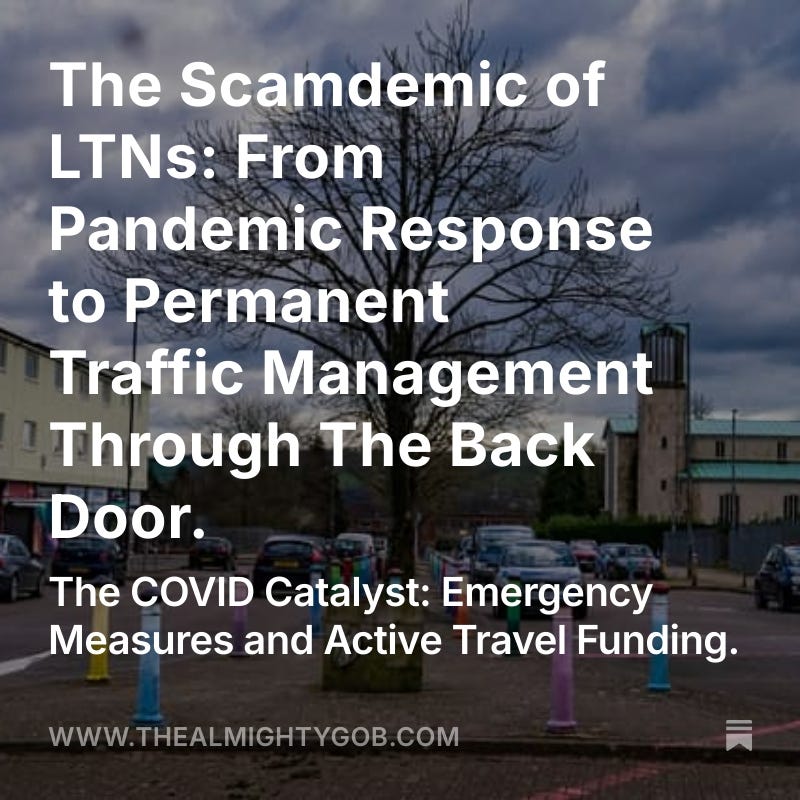The Scamdemic of LTNs: From Pandemic Response to Permanent Traffic Management Through The Back Door.
The COVID Catalyst: Emergency Measures and Active Travel Funding.
1. The COVID-19 Catalyst: Emergency Measures and Shifting Priorities.
The emergence of Low Traffic Neighbourhoods (LTNs) in the UK can be fundamentally traced back to the unprecedented circumstances of the COVID-19 pandemic in 2020. As the nation grappled with lockdowns and social distancing measures, the UK government introduced the Emergency Active Travel Fund. The explicit aim of this funding was to encourage walking and cycling as alternatives to public transport, facilitating social distancing and promoting healthier lifestyles during a period of significant disruption. Local authorities were provided with funding to rapidly implement schemes that would create more space for active travel.
Crucially, the urgency of the pandemic response led to relaxed consultation requirements for these temporary measures. This allowed councils to bypass potentially lengthy public engagement processes that would typically precede significant changes to road layouts. The framing of these schemes as temporary interventions to address immediate pandemic-related transport challenges provided a window for swift implementation.
2. The Ealing Experience: Early Implementation and Unforeseen Consequences.
Ealing in West London became an early adopter of LTNs, implementing its first tranche of nine schemes in the summer of 2020. The West Ealing Liveable Neighbourhoods Programme, with an estimated cost of around £8 million (partially funded through Liveable Neighbourhoods funding and council match funding), aimed to create quieter, safer streets.
However, these early implementations faced significant public criticism and legal challenges. While Ealing Council reported a substantial income of over £4.8 million from fines (Penalty Charge Notices - PCNs) related to these initial LTNs up to October 2021, this revenue stream did not negate the controversy surrounding the schemes. Amendments to the existing LTNs continued, with an additional £0.174 million in capital expenditure approved in October 2023. The perception of the Ealing LTNs as "disastrous," though subjective, was fueled by the intensity of public opposition and the legal battles they triggered. The costs associated with specific elements like the Hamilton Road W5 traffic scheme were described as "minimal," focusing on signage and ANPR cameras, highlighting the varying financial implications of different interventions. Notably, the council also incurred unspecified legal costs related to challenges brought by campaign groups.
3. Beyond the Pandemic: Normalisation and Evolving Justifications
As the immediate urgency of the pandemic subsided, the narrative surrounding LTNs began to shift. What were initially presented as temporary measures to facilitate active travel during an emergency started to be framed as longer-term strategies for achieving broader urban planning goals. These goals included reducing traffic congestion, improving air quality, and creating more liveable neighbourhoods.
Experiences in other areas like Exeter and Warrington further illustrate this evolution. Exeter implemented point closures under the Emergency Active Travel Fund, but the Heavitree and Whipton LTN scheme faced strong opposition and was eventually scrapped. Similarly, the LTN in the Westy area of Warrington was also removed following significant public backlash and the withdrawal of government funding for new LTN schemes. These cases highlight the challenges faced when temporary pandemic measures transitioned into potentially permanent traffic management systems without sustained public support.
4. Bristol's Green Administration: Embracing and Expanding the LTN Agenda
In Bristol, under a Green-led administration, the concept of LTNs, often referred to as "Liveable Neighbourhoods," has been actively embraced and expanded. The primary source of funding for these initiatives in Bristol is now the UK Government's City Region Sustainable Transport Settlement (CRSTS), allocated to the West of England Mayoral Combined Authority (WECA), which then distributes funds to local projects. This shift in funding source signifies a move away from the emergency pandemic funding towards a more established transport budget.
Projects like the East Bristol Liveable Neighbourhood trial and the early planning stages for the South Bristol Liveable Neighbourhood explicitly cite the CRSTS as a key funding source, alongside potential Section 106 developer contributions. This indicates that the Green administration in Bristol is leveraging existing funding streams to implement a broader network of LTNs, aligning with their environmental and sustainable transport objectives.
The accusation arises that the Bristol administration has "jumped on the existing bandwagon" of LTNs, initially conceived under pandemic conditions, as a surreptitious excuse to enforce traffic legislation under the guise of creating "Liveable Neighbourhoods." Critics argue that the initial temporary justification rooted in public health has been manipulated to implement a long-term traffic management strategy that may not have garnered the same level of public support without the initial emergency context. The shift in focus from temporary active travel measures to broader goals of congestion reduction and environmental improvement, while valid in themselves, is seen by some as a strategic leveraging of the LTN framework established during the pandemic.


